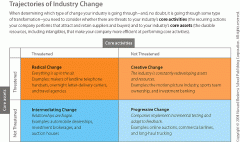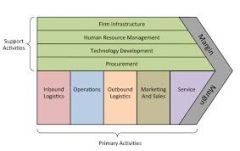![]()
![]()
![]()
Use LEFT and RIGHT arrow keys to navigate between flashcards;
Use UP and DOWN arrow keys to flip the card;
H to show hint;
A reads text to speech;
58 Cards in this Set
- Front
- Back
|
A business model answers which 4 questions? |
1. Who is the customer? 2. What does the customer value? 3. How do we make money in the business? 4. What is the underlying economic logic that explains how we can deliver value to the customer at an appropriate cost? |
|
|
What two parts do business models consist of? |
1. Focused on making something (raw materials) 2. All the activities associated with selling |
|
|
What are the two reasons that business models fail? |
1. They fail the narrative test (story doesn't make sense) 2. Numbers don't add up |
|
|
What does a competitive strategy explain? |
How you will do better than your rivals |
|
|
Experience curve? |
Total costs are declining because of economies of scale and organizational learning |
|
|
What was the BCG strategy recommendation? |
Maintain a balance between cash cows and stars while allocating some resources to feed question marks. Dogs were to be sold off. |
|
|
What are the 5 forces that shape competitive strategy? |
1. Threat of new entrants 2. Bargaining power of buyers 3. Bargaining power of suppliers 4. Threat of substitutes 5. (in the middle) Rivalry among competitors |
|
|
Entry barriers? |
Advantages that incumbents have relative to new entrants |
|
|
Switching costs? |
Costs that companies face when switching suppliers |
|
|
How can these 4 forces hurt prospective profits? |
1. Savvy customers can force down prices by playing you off against your rivals 2. Powerful suppliers may constrain your profits if they charge higher prices 3. Aspiring entrants can ratchet up the investment required for you to stay in the game 4. Substitute offerings can lure customers away |
|
|
How to neutralize supplier power? |
Standardize specifications for parts so your company can switch more easily among vendors |
|
|
How to counter customer power? |
Expand your services so it's harder for customers to leave you for a rival |
|
|
How to temper prices initiated by established rivals? |
Invest more heavily in products that differ significantly from competetion |
|
|
How to scare off new entrants? |
Elevate the fixed costs of competing e.g escalating R&D expenditures |
|
|
How to limit the threat of substitutes? |
Offer better value through product accessibility |
|
|
What are 3 advantages incumbents have over new entrants? |
Customer switching costs, supply-side economies of scale and restrictive government policy |
|
|
When is a supplier group more powerful? |
1. When there is no direct substitute 2. When it offers differentiated products |
|
|
When do buyers have negotiating leverage? |
When there are few buyers and when they threaten to produce the product themselves |
|
|
When is the threat of substitutes high? |
When buyer's switching cost is low |
|
|
Zero sum competition? |
One firm's gain is another one's loss and this drives down profitability of the industry |
|
|
4 factors that affect competition according to Porter? |
1. Industry growth rate 2. Technology and innovation 3. Government 4. Complementary products and services |
|
|
4 trajectories of change? |
1. Radical: everything is up in the air 2. Intermediating: relationships are fragile 3. Creative: constantly redeveloping e.g movies 4. Progressive: incremental |
|
|
Table of the trajectories of change? |

|
|
|
What are the 4 stages in the alternate industry lifecycle? |
1. Emergence 2. Convergence 3. Co-existance 4. Dominance |
|
|
What makes a resource valuable? |
1. Scarcity 2. Appropriability 3. Demand |
|
|
What are the 3 strategically valuable resources? |
1. Physical assets 2. Intangible assets 3. Organizational capabilities |
|
|
What are the 5 characteristics of strategically valuable resources? |
1. Difficult to copy 2. Depreciate slowly 3. The company controls the value 4. Not easily substituted 5. Superior to similar resources the competitor has |
|
|
RBV? |
basis for the competitive advantage of a firm lies primarily in the application of a bundle of valuable tangible or intangible resources at the firm's disposal |
|
|
What are the 4 characteristics of inimitability? |
1. Physical uniqueness e.g unique location 2. Path dependency 3. Causal ambiguity 4. Economic deterrence |
|
|
Path dependency? |
Resources are unique because of all that has happened along the pathtaken in their accumulation (e.g brand connotation) |
|
|
Causal ambiguity? |
Would-be competitors fail because it isimpossible to identify either what the valuable resource is or how to re-createit |
|
|
What are the 5 tests of a resource? |
1. Test of inimitability 2. Test of durability 3. Test of appropriability 4. Test of sustainability 5. Test of competitive superiority |
|
|
The best of resources are usually ______ |
Intangible |
|
|
Transient advantage? |
strategy that prioritizes fast innovation to build a pipeline of competitive advantages |
|
|
Wave of transient advantage phases? |
1. Launch 2. Ramp-up 3. Exploit 4. Reconfigure 5. Disengage |
|
|
8 types of cost drivers? |
1. Economies of scale 2. Economies of learning 3. Improved process technology 4. Improved product design 5. Process redesign 6. Capacity utilization 7. Cost of inputs 8. Residual efficiency |
|
|
5 steps in a cost analysis by studying the value chain? |
1. Identify the separate activities of the value chain 2. Find the contribution of each activity to total cost 3. Determine the cost drivers for each activity 4. Define how costs in one activity influence costs in another 5. Identify other cost-cutting opportunities |
|
|
Value chain activities (graph)? |

|
|
|
TQM? |
Rigorous analysis of production activities, simplification of processes and training |
|
|
Differential advantage? |
a benefit or cluster of benefits that customers value and believe they cannot obtain anywhere else. |
|
|
Intangible differentiation? |
when the value that customers perceive in a product is not dependent exclusively on tangible aspects of the offering |
|
|
Examples of how to use the value chain to identify opportunities for differentiation advantages in 3 steps? |
1. Define and draw the value chain 2. Identify different drivers of uniqueness 3. Select the differentiation strategy |
|
|
What are the 5 primary activities in the value chain? |
1. Inbound logistics 2. Operations 3. Outbound logistics 4. Marketing + sales 5. Service |
|
|
What are the 4 secondary activities of the value chain? |
1. Firm infrastructure 2. HR management 3. Technology 4. Procurement |
|
|
Corporate scope? |
Which business should a firm expand into? |
|
|
5 questions to ask when evaluating a scope expansion? |
1. Timing: what is the motive to expand now? 2. Industry: how attractive is target industry? 3. Synergies: where are the scope economies with our existing businesses? 4. Implementation: what organizational changes are necessary to exploit scope economies? 5. Ownership: where should boundaries of firm be drawn? |
|
|
Big T? |
Improvements based on innovation, no the product itself |
|
|
Small t? |
Innovation of the product, not the business |
|
|
Value proposition? |
The unique added-value an organization offers customers |
|
|
What are the business model characteristics of Zara? |
-Globalization through localization -Vertical integration: flexibility -Premium image with scarce publicity -Investment in brands -Imitation vs innovation costs |
|
|
What are the advantages of the Zara business model? |
-Sales team focuses on customer, perceives trends and quick answer to these trends -Design team: bridge between advantage quality procurement and sales advantage |
|
|
What are the business model characteristics of Dell? |
-customized -directly ordered online -free and fast delivery -low prices -low inventory |
|
|
What are the business model advantages of Dell? |
-cost reduction -concentration added value: from suppliers to clients -client proximity -no intermediaries: lack of channel conflict |
|
|
What are the 3 levels of strategy? |
1. Corporate strategy 2. Business strategy 3. Functional strategy |
|
|
Difference between vision statement and mission statement? |
Vision statement: the future direction of the business Mission statement: the present scope of our business |
|
|
4 questions in the Diamond Model? |
1. Where will we be active? 2. How will we get there? 3. How will we win? 4. What will be our speed and sequence of moves? |
|
|
4 types of change people? |
1. Traditionalist 2. Detractor 3. Observer 4. Agent of change |
|
|
What are the strategic implications of Porter's 5 forces? |
1. Position the company where forces are at its weakest 2. Exploit industry change |

